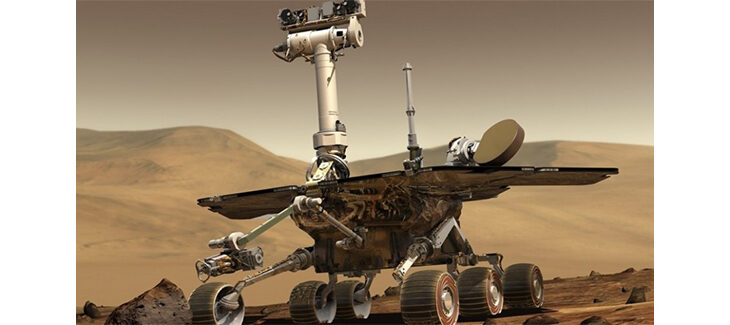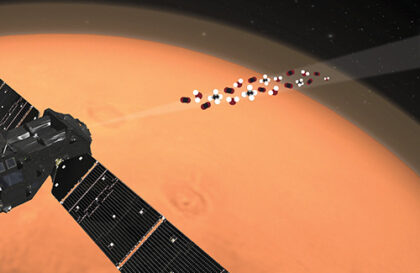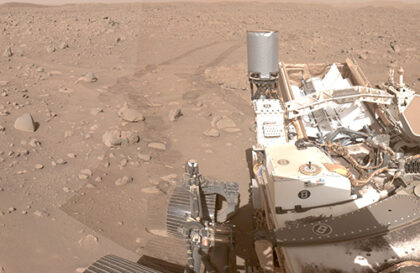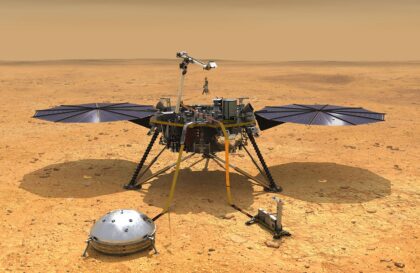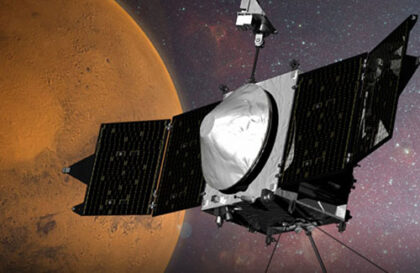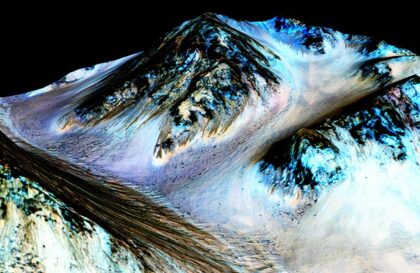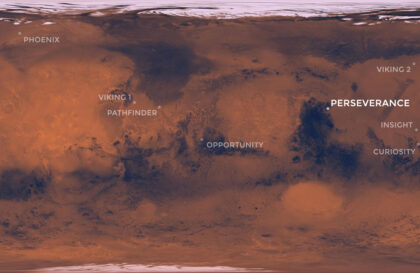Spirit (or MER-A, short for Mars Exploration Rover – A) was the first of two rovers in NASA’s Mars Exploration Rover project, launched on June 10, 2003, and soft-landed on Mars on January 4, 2004, three weeks before landing. Its “twin” “Opportunity” (MER-B) is in another area of the planet. The rover landed approximately 10 km from the center of the planned landing ellipse.
An image taken from the Mars Exploration Rover Spirit’s PanCam at the spacecraft’s landing site shows the nearby hills named after the crew of Apollo 1-Gus Grissom, Edward White, and Roger Chaffee. The crew perished in flash fire during a launch pad test of the spacecraft at Kennedy Space Center on Jan. 27, 1967. Credit: NASA
The main task is to survive
Spirit was involved in Mars exploration with a planned mission duration of 90 sol (92.5 Earth days), but continued operations until approximately 2208 sol. On August 11, 2007, the rover updated the record for operating duration on Mars, becoming the second longest-serving vehicle after Viking 2, powered by solar batteries. Viking 2 used nuclear power.
Spirit transmitted its final message on March 22, 2010, having operated and traveled significantly longer than planned: working over 90 sols and traveling 4 miles 14 yards (7.73 km) versus the planned 600 m (656 yards). Increased energy production due to wind cleaning of solar panels allowed the rover to efficiently explore the geology of Mars, significantly exceeding life expectancy.
The last sols of life
On May 1, 2009, after more than five years of service, Spirit became stuck in a dune on Mars, operating 21.6 times longer than the planned 90 sols. NASA actively analyzed and simulated the situation for eight months, attempting to free him, which continued until January 26, 2010. However, recreating the situation on Earth is difficult due to differences between Martian and Earth conditions, such as gravity and atmospheric pressure. The rover could not be helped.
Despite mobility problems and having only five impellers, the rover continued scientific research on-site in a location called “Troy.”
The benefits of a broken wheel
After running 7 km on Mars, the Spirit’s right front wheel failed, which has led to it being driven in reverse since 2007. The non-impeller dragged as it scraped away layers of Martian soil, providing data on the possible past suitability of conditions on Mars for microbial life. On November 29, 2009, the right rear wheel also failed. Since March 22, 2010, on the 2210th Martian solar day (sol) of the mission, communication with the rover, which served as a stationary platform, was lost, and since then, no new messages have been received from it.
Why did Spirit fall into deep sleep?
Spirit likely went into deep sleep due to a malfunction caused by low energy levels, shutting down communications and other subsystems and attempting to charge its batteries. There is a risk that the rover could turn off its mission clock, losing track of time and only waking up when there is enough sunlight on the batteries (Solar Cool state). In this case, it will only receive signals. As of July 26, 2010 (Sol 2333), a mission clock troubleshooting procedure was implemented.
Dispatchers’ efforts to save Spirit
Mission controllers send “Sweep & Beep” audio commands every sol to the rover via the Deep Space Network if its clock fails. Due to possible glitches, the rover listens for these commands at 20-minute intervals every waking hour without knowing the exact time. If the rover picks up the command, it will send an audio signal back, allowing the team to study its status.
Weather conditions on Mars were expected to improve after May 13, 2010, with the onset of the southern winter solstice, and the rover would wake up. But the answer from Spirit never came.
The total odometry of Spirit was 7730.50 meters (4.80 miles).
JPL attempted to re-establish contact with the rover until May 24, 2011, when NASA announced that efforts had failed and the rover remained silent. Farewell to Spirit took place at NASA headquarters and was broadcast on NASA TV.
The legacy of the Spirit rover
First drilling on Mars
The Spirit rover first drilled into a rock on Mars on February 6, 2004, creating a 2.65 mm deep, 45.5 mm diameter hole in Adirondack rock. This hole was perfectly round and free of dust. It provided access to fresh rock for examination by the microscopic camera and spectrometers on the rover’s robotic arm, and a picture of the hole taken by the panoramic camera helped quickly assess the success of the drilling.
Images showing the hole drilled in Adirondack by the Rock Abrasion Tool (RAT), and the RAT next to Adirondack where it was first used to remove dust from the surface. Images and captions courtesy NASA/JPL
Area exploration
Image of the rock nicknamed “Adirondack” and an image of the rover arm moving towards it. Images and captions courtesy NASA/JPL
The rim and interior of a crater nicknamed “Bonneville” dominate this 180-degree, false-color mosaic of images taken by the panoramic camera of NASA’s Mars Exploration Rover Spirit. Spirit recorded this view on the rover’s 68th sol, March 12, 2004, one sol after reaching this location. The rover remaining here in part to get this very high-resolution, color mosaic, from which scientists can gain insight about the depth of the surface material at Bonneville and make future observation plans. The light blue object on the far rim of the crater is Spirit’s heat shield. Images and captions courtesy NASA/JPL
This enhanced false-color mosaic image from the Mars Exploration Rover Spirit panoramic camera shows the view acquired after the rover drove approximately 50.2 meters (165 feet) on the martian afternoon of sol 89 (April 3, 2004). The view shows the direction of the rover’s future drive destination. In the distance are the eastern-lying “Columbia Hills.” This image was assembled from images in the panoramic camera’s near-infrared (750 nanometers), green (530 nanometers), and violet (432 nanometers) filters. The colors have been exaggerated to enhance the differences between cleaner and dustier rocks, and lighter and darker soils. Images and captions courtesy NASA/JPL
Revival after a dust storm
In October 2007, the Mars rover “Spirit” faced the problem of dust accumulation on solar panels. In June, dust storms began, which intensified by July and seriously threatened the functioning of the rover due to blocking 99% of direct sunlight needed to generate energy.
Under normal conditions, the rovers’ solar panels generated about 700 watt-hours of energy per day, but the figure dropped to 128 watt-hours during the dust storm. Below 150 Wh, the batteries began to discharge, threatening the equipment due to the cold (heaters turned off). Engineers minimized the rovers’ power consumption to survive the storm, which began to subside toward the end of August, allowing the batteries to charge. The rover continued its mission.
For Spirit’s invaluable contribution to the study of Mars, the asteroid (37452) Spirit was named in his honor.
Banner image:
Image credit:
https://mars.nasa.gov
https://www.nasa.gov
https://nssdc.gsfc.nasa.gov
